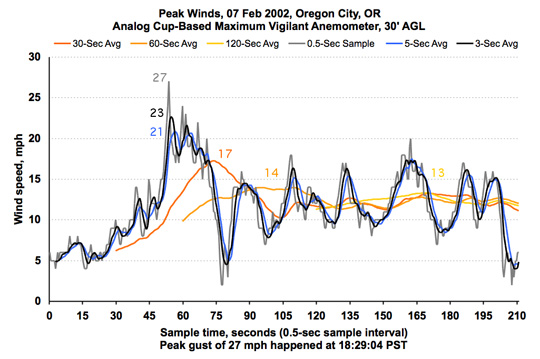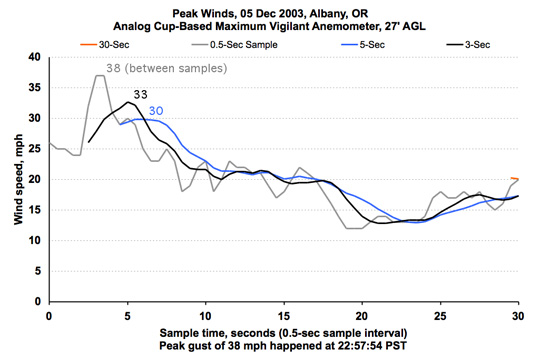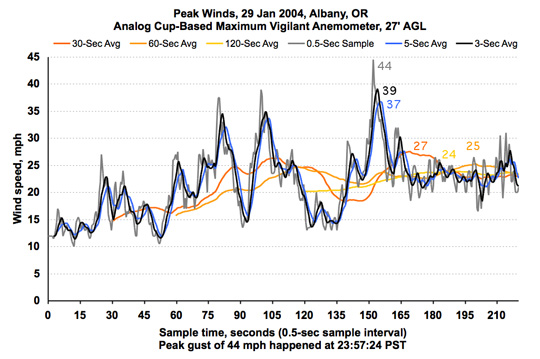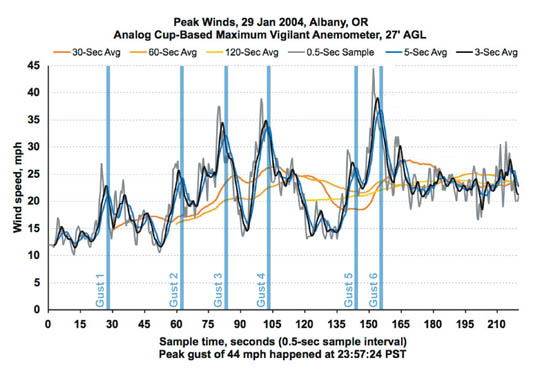|
Storm watchers, pay close attention to the modified readings for the Columbus Day Storm. That's the 5-sec gust signature of a "storm-of-the-century" event. The extreme instant gust values are reduced considerably, with the storm's average falling close to the unmodified value for the November 14, 1981 windstorm. With peak gusts depicted in estimated 5-second averages, the Columbus Day Storm stands out somewhat less. Gusts in the 60s and 70s don't seem as spectacular as 80s, 90s, and 100s. Nevertheless, even with the reduction, some stations still have a strong showing, including Portland, OR, with an 87 mph 5-second wind. Of course, the 104 mph was an estimate--a necessity as the storm knocked out power early and shut down the direct-reading wind equipment. Using the measured value of 106 mph at Troutdale, we get 89 mph, which does stand out, and is a close match to an 88 mph "fastest mile" (88 mph 41-second wind) at Portland that was recorded near the beginning of the storm. In any event, a Columbus-Day type of event would show up numerically less strongly in a 5-second wind regime, but, owing to some stations being subjected to particularly strong winds (and the physical reality of the kind of damage such a storm would cause), will still stand out as something unusual.
For an extreme, but not Columbus-Day-Storm-extreme, event like November 14, 1981, the story is different. Save for at North Bend, the peak wind values do not stand out much. Many storms in history have produced 50 to 60 mph instant gusts. The average of 55.4 is still in major category, but is right at the borderline. This clearly demonstrates how peak 5-second gusts can "mask" a rare windstorm. This table suggests that the 5-second gust signature for a major event is 50 to 60 mph gusts, not 60 to 75.
There's another twist to the story being examined here: What happens to the frequency of high wind warnings between the pre and post 5-second-gust eras? Did more than one standard for a high wind event, by NWS definition, change?
High Wind Warnings in the Five-Second Gust Era
National Weather Service criteria for a high wind warning (HWW) event is for gusts of 50 knots, or 58 mph, to occur within the warning area. Gusts meeting this criterion are shown in red in Tables 2 and 3. This definition has been around some time; minimum HWW criteria during the pre-ASOS era certainly wasn't higher. I recall a few high wind warnings for 55 mph gusts in the Seattle area during the 1980s.
If the NWS bases its wind forecasts on how the official stations respond, then, quite possibly the frequency of HWW might have decreased since the inception of ASOS. Note that three storms in Table 4 did not produce HWW criteria "gusts" under the official peak 5-second wind record of ASOS: February 5, 1999, February 6, 1999 and December 3, 2003. Yet, based on the 1.19 adjustment factor, it appears that these three events could have achieved gusts of 58 mph or higher at coastal stations. For the last storm, this point is kind of moot, for a HWW was issued for the coast (one that was verified by stations not included in the table).
High wind warnings for the interior sections, like the Willamette Valley, are rare. The difference between peak 5-second wind and peak instant gust is probably more significant than on the coast, where gusts to 60 and 70 mph are regular occurrences during the winter season. The January 1, 1997, March 3, 1999 and December 27, 2002 windstorms, which generally didn't have a strong showing in the interior for 5-second wind measures (save SEA and BLI in 1999), meet HWW criteria with the peak instant gust adjustment, either at one point, or over a wider portion of the inland region.
Another way of looking at this is with Table 6, especially the November 14, 1981 windstorm. The number of stations meeting HWW criteria drops from 10 to 3 when the peak instant gusts are adjusted to 5-second wind! The storm appears to barely meet the high wind warning standard, yet it was one of the biggest in history.
It seems that the standard for high wind was automatically changed by employing a new peak 5-second "gust" at official stations. Instant gusts of 69 mph are a reasonable expectation when 5-second winds are approaching 58. So, the new ASOS era appears to have changed the HWW criteria to approximately a minimum of 70 mph for instant gust. The other way to look at this is that peak 5-second winds of 48 to 50 mph (implying potential instant gusts of 57 to 60 mph) at ASOS stations would have likely met the minimum HWW criteria pre-ASOS. It seems that 5-second "gusts" of 43 knots, approximately 50 mph, might have been a reasonable new criteria for high wind warnings, certainly for interior sections of the Pacific Northwest (there's good reason to distinguish between coastal and interior regions when providing wind advisories and warnings, a topic in its own right).
Since it's doubtful that 58 mph instant gusts have changed in force during the implementation of the 5-second gust, it's interesting that the NWS has kept the 58 mph minimum for HWW when using a 5-second wind to "verify" warnings. Skywarn spotter reports probably reduce this issue to some extent. A number of personal anemometers still report instant gust in analog format (Maximum equipment being one example), though digital stations that show short-duration averages, like 2.5-seconds on Davis systems, are also common, watering down the effect.
The bottom line: The 5-second gust era of 1996-2006 was different from the periods both before and after. A 5-second average on a cup-based anemometer system is a unique kind of wind measure. This should be kept in mind when trying assess the strength of a particular wind event relative to other storms in history.
|



